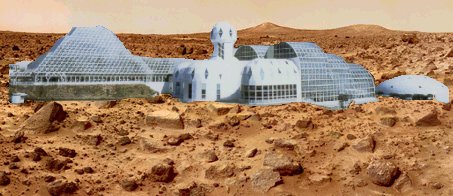
Images courtesy of Biospherics and NASA/JPL/Malin Space Science Systems

When the idea of building Biosphere II was first presented to the public, the media greatly emphasized the project's potential ramifications for colonizing Mars or the Moon. If a self-sustaining ecosystem could be created to support humans on Earth, why couldn't one be built on another planet? These ideas struck the public imagination and drew considerable interest. Even the name of Space Biosphere Ventures, which was the private company that designed and built Biosphere II, played on this media hype. However, the scientific community remained skeptical that Biosphere II would lead to colonies on Mars any time soon.
Perhaps a more
important and realistic goal of Biosphere II involved the study of ecosystems
as they already exist in Biosphere I. A key factor in any scientific experiment
is the ability to control all of the relevant factors. Biosphere II, because
it is a closed system, allows more control than ecologists could ever have
in the "real world". Even after the initial failure of Biosphere II's "mission",
this research aspect of its intended use has continued today. Columbia
University now owns the facility, which it uses to conduct a variety of
studies, particularly ones related to the carbon dioxide cycle. Public
tours are also available, and students of all ages visit
Biosphere II regularly.
[Home][Earth:
Biosphere I][Why Biosphere II?] [Biosphere
Plans] [Grand Experiment] [What
Went Wrong?][Lessons for the Future]